List of Authors
>>About this blog
Recent blog post
|
[Yotaro]
December 26, 2013 09:00
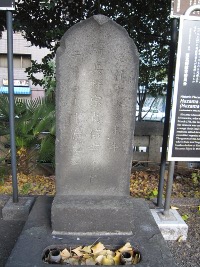 Speaking of Shiwasu, Ako Gishi was defeated, and at Kabukiza Theater, "Kanademoto Chushingura" ... one story related to Chushingura again this year. Speaking of Shiwasu, Ako Gishi was defeated, and at Kabukiza Theater, "Kanademoto Chushingura" ... one story related to Chushingura again this year.
I think many people know that one of the forty-seven men, the grave of Shinroku Hazama, is located at Tsukiji Honganji Temple. Of the forty-six people except Kichiemon Terasaka, who disappeared after the defeat, the only one Shinroku was buried outside Sengakuji. This is due to the fact that on February 4, 1703 (1703), Shinroku's son-in-law, Matasuke Nakado, who was the retainer of the late Akimoto Tajima Mamoru, took the remains from Mohri Kaimori's house where Shinroku was cut off and buried them at Tsukiji Honganji in the Chudo family Bodaiji Temple. (A tombstone will be built at Sengakuji on the 35th with other lawyers. posthumous Buddhist name is a friend of mine.
Shinroku has joined the debate with his father, Kibei (cut at Hosokawa Echinaka Mori's House) and his brother Jiro (cut at Kenmotsu Mizuno's House), so (only the three parents and children also participated.) .) There seems to be a direction that seems to be "Why only Shinroku?", But after the stomach was transported to Sengakuji Temple with a time difference in the order of Hosokawa, Mizuno, Matsudaira Okimori, and Mori family, Nakado Masuke finally went to the Hosokawa family of Kibei and the Mizuno family of Ju Jiro, but the body was already consideredMori family. In addition, it is reported that Shinroku tied Kaneko to a spear and put it in Honganji during the withdrawal of Sengakuji from Honjo Kira's residence, and asked for a memorial service, but it will be later story.
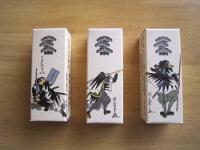 There is only one new six ... one other. The manners on the stomach was already formal at the time, and it is natural for an interrogator to drop his neck before cutting his belly, but it is said that Shinroku's assistant cut it into one letter before he shook his sword. It seems that he was a tough brother, called his brother, who was given the spear to Kira Uenosuke and was the most involved. There is only one new six ... one other. The manners on the stomach was already formal at the time, and it is natural for an interrogator to drop his neck before cutting his belly, but it is said that Shinroku's assistant cut it into one letter before he shook his sword. It seems that he was a tough brother, called his brother, who was given the spear to Kira Uenosuke and was the most involved.
The other day (the 14th), I went to the Gishi Festival at Sengakuji Temple, but there were more people than usual, so I could hardly reach the Gishi burial ground, so I gave up immediately and went to Tsukiji Honganji Temple and visited the quiet Shinroku grave.
[On the photo] The tomb of Shinroku at Tsukiji Honganji Temple, rebuilt during the Tenpo era. This posthumous Buddhist name is "Seishinshakumune Sadanobu".
[Lower photo] It was sold at "Gishi Yokan" in Shimbashi / Shinsho-do (close to the site of Tamura Ukyo Daio's House, where the inner Takumi was cut off, and famous for "in the middle of the stomach"), and at the B2F Kibikicho Square in Kabukiza . Left: Mashin Rokuro (black sugar): Kihee Hazama (salt) right: Jujiro Hazama (black sugar)
[Yotaro]
October 31, 2013 09:00
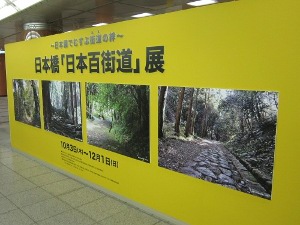 A road that extends in all directions from Nihonbashi, the starting point of highways and national roads in the center of Japan. It leads to attractive highways and streets in various places. A place to disseminate information on the history and culture of the highway city "Nihonbashi" Hyakukaido "Exhibition 2013" is being held near the underground concourse in front of Mitsukoshi and the Kidai Shoran compound picture scroll. It's free. Until December 1 A road that extends in all directions from Nihonbashi, the starting point of highways and national roads in the center of Japan. It leads to attractive highways and streets in various places. A place to disseminate information on the history and culture of the highway city "Nihonbashi" Hyakukaido "Exhibition 2013" is being held near the underground concourse in front of Mitsukoshi and the Kidai Shoran compound picture scroll. It's free. Until December 1
This year's exhibition will include “Nihonbashi / Yaesu / Kyobashi Chuo-ku Town Walking” in Chuo-ku, “Hundred Roads in Japan”, “Kiso Nakasendo”, “Hida Takayama Historical Road”, “History City Takaoka”, “Yokohama Old Tokaido”, “Mie History Road”, etc.
One Hyakukaido, who is provided with photos of the Kamakura Highway in this exhibition, is a leading figure in walking along the old highways in various parts of Japan, and his blog `` One Hyakukaido One Step Road Chronicles / Festival Exploring '' Has many readers nationwide. One Hyakukaido is a passer of the Edo Cultural History Certification First Class and the Kyoto / Tourism Cultural Certification First Class, but we are also the first passers of the Chuo-ku Tourism Certification.
If you want to travel, how about not only hot springs and gourmet, but also walking along the highways and streets? I would like to recommend this exhibition and the blog of Hyakukaido as a guide.
* "Nihonbashi: 100 Kaido Japan Exhibition 2013"
Sponsored NPO National Highway Exchange Conference, Nabashi Nihonbashi Preservation Society
Co-sponsored Highway Exchange Chiefs' Association, Japan Road Association, etc.
Other than supporting Chuo-ku
Ministry of Internal Affairs and Communications, Ministry of Land, Infrastructure, Transport and Tourism, Ministry of the Environment, Japan Tourism Agency, Japan Chamber of Commerce and Industry, Japan Walking Association and others
* "Hyakukaido One Step Road Chronicles and Festival Exploring"
http://hyakkaido.travel.coocan.jp/
[Yotaro]
August 30, 2013 10:00
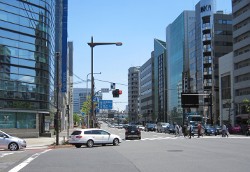 In August 1893, Shohachi Kimura (1893-1958), famous for Kafu Nagai's “Illoha”, a beef shop at 1-1 Yoshikawacho, Nihonbashi-ku (currently Higashi Nihonbashi, Chuo-ku) In August 1893, Iroha was the eighth child of a businessman Shohei Kimura. This year marks the 120th anniversary of birth of the Chinese zodiac sign. In August 1893, Shohachi Kimura (1893-1958), famous for Kafu Nagai's “Illoha”, a beef shop at 1-1 Yoshikawacho, Nihonbashi-ku (currently Higashi Nihonbashi, Chuo-ku) In August 1893, Iroha was the eighth child of a businessman Shohei Kimura. This year marks the 120th anniversary of birth of the Chinese zodiac sign.
It seems that there were as many as 30 brothers and sisters in Shohachi, but many were blessed with artistic heavens, sister Eiko (Akebono), brother Sota, and brother Soju are writers, and brother Sotoji is a film director. I am named as a director. Shohachi's main business is oil paintings that played an active part in Fuzankai, Sodosha, and Shunyokai, but it was also very popular in the field of illustrations, and was a cultural person who performed various activities such as stage art and hobby kouta. In particular, he has demonstrated his talent in writing, and has left many wonderful sentences that talked about "hometown" Tokyo as a genuine Tokyo person born in Tokyo and loves Tokyo. (Souhachi Kimura, a literary artist, was awarded the Art Academy Prize for "Tokyo Shigeshoki" after his death. In addition, Kodansha has published a total of eight volumes of "Kimura Shohachi Complete Works". )
By the way, where is Yoshikawa-cho 1 now? After the war, the painter himself lamented the transformation, saying, "... Where did you born ... Even if you actually go to that area, you can hardly find ..." ("Ryogoku Past") Is it a little south of the Ryogoku Post Office (2-27-12 Higashi-Nihonbashi), east of the Yasukuni Dori Asakusabashi intersection? (Although he said, "Ryogoku" refers to the west side of Ryogoku Bridge, the Chuo-ku side. It seems that there was also the name of Ryogoku Yoshikawa-cho. You can feel a remnants of the post office name. The east of the bridge is "East Ryogoku", and now "Ryogoku" comes to mind only this Sumida-ku side. ) Here, "A corner shop with a wide frontage and a glass door on the front of the second floor with five-colored glass" ("Ryogoku neighborhood") was the eighth branch of "Iroha" beef shop (= Ushinabeya) . Inside the store, the entrance is depicted in one of the representative works, "Beef Store Bookhouse".
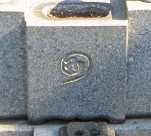 This year, the 120th anniversary of his birth, a retrospective exhibition was held at the Tokyo Station Gallery in Chiyoda-ku, next door. Unfortunately, there seems to be no special event in the birthplace of Chuo-ku, where he loved, so on August 21, the day of birth, I thought that it was the former Yokawacho, and hit the street iron I hit the street iron. I played a large kite of a warrior painting that I bought for two yen and fifty yen of a tiger boy who hit a five-sixed nails on the streets of Koyako. This year, the 120th anniversary of his birth, a retrospective exhibition was held at the Tokyo Station Gallery in Chiyoda-ku, next door. Unfortunately, there seems to be no special event in the birthplace of Chuo-ku, where he loved, so on August 21, the day of birth, I thought that it was the former Yokawacho, and hit the street iron I hit the street iron. I played a large kite of a warrior painting that I bought for two yen and fifty yen of a tiger boy who hit a five-sixed nails on the streets of Koyako.
[On the photo] From Asakusabashi intersection, look toward Ryogokubashi.
[Lower photo] The signature of the artist carved on the tomb of Enji, Suginami Ward
[Yotaro]
July 31, 2013 09:00
In the Harumi area, landfill began in the sea during the Edo period in the Taisho era, completed in 1931 (1931), and 230,000 tsubo of "Tsukishima No. 4 Reclaimed Land" was transferred to Kyobashi Ward, and in 1937 (1937) Was named Harumi. Because it is a new land, it seems that there is no connection with "historic sites", but surprisingly a wonderful monument has been built.
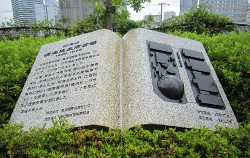 Speaking of Harumi, the elderly like me first associate the international trade fair venue, but there is a monument near the entrance of the Central Incineration Plant (5-2-1 Harumi). Speaking of Harumi, the elderly like me first associate the international trade fair venue, but there is a monument near the entrance of the Central Incineration Plant (5-2-1 Harumi).
In Harumi, the first Japan International Trade Fair was held in 1955 (1955), and in 1959 (1959), Japan's largest trade fair venue was completed. The Tokyo Motor Show, Electronics Show, Data Show, Comic Market, etc. were held as one of Japan's leading convention centers. It was closed in 1996 (1996) with the completion of the Tokyo Big Sight in Ariake, but it is said that there were 6 million visitors annually at its peak.
A trade fair venue with seven buildings lined up on a site of more than 60,000 tsubo ... reminiscent of those days, there is only this monument in the shape of an open book.
(It seems that there are few visitors. When you go to "Hot Plaza Harumi", it is next to you, so please drop in. )
[Yotaro]
June 28, 2013 17:00
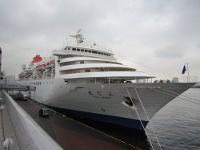 At the Harumi Passenger Terminal, the familiar passenger ship "Fujimaru" will retire at the end of June. Fujimaru is Japan's first full-fledged luxury cruise ship owned by Mitsui O.S.K. Lines and operated by the Japan Charter Cruise. In 1989, the first year of the cruise was also called the first year of the cruise. In 25 years, the voyage over 70 laps of the earth was used by 500,000 people. It's lonely that the pure white hull, orange fannel marks, chic and beautiful appearances will not be seen. At the Harumi Passenger Terminal, the familiar passenger ship "Fujimaru" will retire at the end of June. Fujimaru is Japan's first full-fledged luxury cruise ship owned by Mitsui O.S.K. Lines and operated by the Japan Charter Cruise. In 1989, the first year of the cruise was also called the first year of the cruise. In 25 years, the voyage over 70 laps of the earth was used by 500,000 people. It's lonely that the pure white hull, orange fannel marks, chic and beautiful appearances will not be seen.
"Fujimaru" In 1987, Mitsui O.S.K. Lines ordered an order from Mitsubishi Heavy Industries Kobe Shipyard, and the launch ceremony was held on September 10, the following year. The name of the ship was publicly recruited, and was named by Minister of Transport Shintaro Ishihara at the time, and Mrs. Ishihara cut a champagne with a golden axe and broke a champagne, creating "Fuji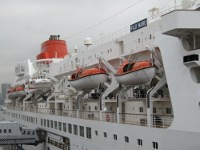 maru". In 1989, after a trial run, it began to be active as Japan's first large cruise liner in April. The total tonnage is 23,235 tons, a total length of 167 m, a width of 24 m, a navigation speed of 18 knots, and a passenger capacity of 600. The eight-layer deck has a hall, theater, pool, large public bath, etc. The class is international ocean and the port of registration is Tokyo. Recently, he was mainly active on charter cruises. maru". In 1989, after a trial run, it began to be active as Japan's first large cruise liner in April. The total tonnage is 23,235 tons, a total length of 167 m, a width of 24 m, a navigation speed of 18 knots, and a passenger capacity of 600. The eight-layer deck has a hall, theater, pool, large public bath, etc. The class is international ocean and the port of registration is Tokyo. Recently, he was mainly active on charter cruises.
"Fujimaru" On the evening of June 30, after the "Thank you! Fujimaru" ceremony at the Harumi Passenger Ship Terminal, depart for the last cruise to Hatsushima, return home on July 1, enter the dock, and probably sell to foreign countries It is said that. Even if the name changes, I want you to call at Harumi again one day and show a beautiful appearance.
[Yotaro]
March 14, 2013 09:00
 "Maruzen World fountain pen exhibition and spot sale" The other day, when I passed through Maruzen in Nihonbashi, I noticed such a guide. Maruzen was a pioneer who invited not only Western books but also Western stationery to Japan of the Restoration. Regarding the fountain pen, the encyclopedia states, "In Japan, Maruzen Co., Ltd. in Tokyo launched a small amount of waterman products at stores in 1895 (Meiji 28), and full-scale imports were in 1902 (Meiji 35). " (The whole book of Japanese University Encyclopedia (Shogakukan))). "Maruzen World fountain pen exhibition and spot sale" The other day, when I passed through Maruzen in Nihonbashi, I noticed such a guide. Maruzen was a pioneer who invited not only Western books but also Western stationery to Japan of the Restoration. Regarding the fountain pen, the encyclopedia states, "In Japan, Maruzen Co., Ltd. in Tokyo launched a small amount of waterman products at stores in 1895 (Meiji 28), and full-scale imports were in 1902 (Meiji 35). " (The whole book of Japanese University Encyclopedia (Shogakukan))).
After that, fountain pens spread rapidly, and a large number of celebrities wrote and sketches (drawn with a fountain pen) in the booklet entitled "Impressions and Illustration Catalog" issued by Maruzen in 1912 (Meiji 45). ) Etc. The beginning of the book is Soseki Natsume (1867-1916)'s "Yoto Mannen Pen".
In this sentence, Soseki says that he has just started using a fountain pen and is less familiar. Twelve years ago, when studying in the UK, a fountain pen that I received as a farewell from a relative (Mrs. Kyoko's sister Tokiko) broke down on the ship by mimicking an instrumental gymnastics (iron bar). Three or four years ago, I bought two "pelicans" in Maruzen, but I returned to the original pen writing because "I was unhappy and I was not very grateful for the remaining pelicans." He said that he felt like "I miss my separated wife later." He said, "This manuscript was written by Roan-kun (Roan Uchida (1868-1929), who was an advisor to Maruzen at the time), and was given to him to look at it, but it was very comfortable and I was able to write smoothly. " This booklet also contains a photo of the manuscript of this sentence written by Soseki in "Onoto G".
It is a sentence that has no advertising smell to put it on a fountain pen PR booklet, but when I read what Luan wrote, "Natsume-san was a person who favored me. I asked me to write about a fountain pen, but I didn't have a bad face, but said, "I'm in trouble." So, no, I just asked you to write something useful because you only have to say it bad." Also, in Soseki's discourse later published in a newspaper, "I'm using the second generation, Onoto." I don't think this is good, but I got it from Maruzen's Roan Uchida, so it's until I use it." Even though I bought the convenience, I didn't think so much. According to Luan, Soseki hated glass ink stands, and ink hated blue black and liked sepia color.
At the time of joining Soseki, the Asahi Shimbun was located in Takiyama-cho, Kyobashi-ku (now Ginza 6-chome), as is known for the song by Takuboku Ishikawa (1886-1912). Sojinkan Sugimura (1872-1945), who entered the morning sun at the invitation of his main writing Ikebe Sanzan (1864-1912), said Soseki rarely came to the office, but when he came out at an editorial meeting held on Wednesday, everyone was laughing and laughing at every moment. Did Soseki's hand at such times have Onoto's fountain pen?
Soseki also favors Onoto, who did it, dominates the world as a luxury fountain pen, but after the war, the manufacturer U.K. de la Luo stopped manufacturing fountain pens. Currently, Maruzen sells a high-end fountain pen of "reprinted version" bearing the name of Onoto. In Nihonbashi Maruzen, the fountain pen section is on the first basement floor. As I looked around the sales floor where everything from ultra-luxury items to popular items was beautifully lined up, I noticed myself, who had no connection with fountain pens for a long time, and at the same time, when I was a child more than fifty years ago, my late parents now came back to the excitement of buying a fountain pen for the first time.
|
Links
|
Speaking of Shiwasu, Ako Gishi was defeated, and at Kabukiza Theater, "Kanademoto Chushingura" ... one story related to Chushingura again this year.
There is only one new six ... one other. The manners on the stomach was already formal at the time, and it is natural for an interrogator to drop his neck before cutting his belly, but it is said that Shinroku's assistant cut it into one letter before he shook his sword. It seems that he was a tough brother, called his brother, who was given the spear to Kira Uenosuke and was the most involved.
 In August 1893, Shohachi Kimura (1893-1958), famous for Kafu Nagai's “Illoha”, a beef shop at 1-1 Yoshikawacho, Nihonbashi-ku (currently Higashi Nihonbashi, Chuo-ku) In August 1893, Iroha was the eighth child of a businessman Shohei Kimura. This year marks the 120th anniversary of birth of the Chinese zodiac sign.
In August 1893, Shohachi Kimura (1893-1958), famous for Kafu Nagai's “Illoha”, a beef shop at 1-1 Yoshikawacho, Nihonbashi-ku (currently Higashi Nihonbashi, Chuo-ku) In August 1893, Iroha was the eighth child of a businessman Shohei Kimura. This year marks the 120th anniversary of birth of the Chinese zodiac sign. This year, the 120th anniversary of his birth, a retrospective exhibition was held at the Tokyo Station Gallery in Chiyoda-ku, next door. Unfortunately, there seems to be no special event in the birthplace of Chuo-ku, where he loved, so on August 21, the day of birth, I thought that it was the former Yokawacho, and hit the street iron I hit the street iron. I played a large kite of a warrior painting that I bought for two yen and fifty yen of a tiger boy who hit a five-sixed nails on the streets of Koyako.
This year, the 120th anniversary of his birth, a retrospective exhibition was held at the Tokyo Station Gallery in Chiyoda-ku, next door. Unfortunately, there seems to be no special event in the birthplace of Chuo-ku, where he loved, so on August 21, the day of birth, I thought that it was the former Yokawacho, and hit the street iron I hit the street iron. I played a large kite of a warrior painting that I bought for two yen and fifty yen of a tiger boy who hit a five-sixed nails on the streets of Koyako. Speaking of Harumi, the elderly like me first associate the international trade fair venue, but there is a monument near the entrance of the Central Incineration Plant (5-2-1 Harumi).
Speaking of Harumi, the elderly like me first associate the international trade fair venue, but there is a monument near the entrance of the Central Incineration Plant (5-2-1 Harumi).
